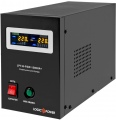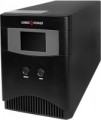Input voltage range
In this case, the input voltage range is implied, in which the UPS is able to supply a stable voltage to the load only due to its own regulators, without switching to the battery. For redundant UPSs (see "Type") this range is quite small, approximately 190 to 260 V; for interactive and especially inverter ones, it is much wider. Some UPS models allow you to manually set the input voltage range.
Bypass (direct connection)
Bypass(by-pass) means such a mode of operation of the UPS, in which power is supplied to the load directly from an external source — the mains, diesel generator, etc. — practically without processing in the UPS itself. This mode can be activated either automatically or manually.
— The automatic bypass is a kind of safety measure. It turns on when the UPS in normal mode cannot supply power to the load — for example, when the UPS is overloaded due to a sharp increase in the power consumption of the load.
— Manual bypass allows you to enable this mode at the request of the user, regardless of the operating parameters. This may be necessary, for example, to hot-swap a battery (see below for details) or to start equipment that has a starting capacity greater than that of the UPS. Technically, it can also play the role of a security measure, but automatic systems are more reliable in this sense.
Some UPSs provide both options for enabling the bypass.
Output voltage accuracy
This parameter characterizes the degree of difference between the AC voltage at the output of the UPS and the perfect voltage, the graph of which has the shape of a regular sinusoid. The perfect voltage is so named because it is the most uniform and creates the least unnecessary load on the connected devices. Thus, the distortion of the output voltage is one of the most important parameters that determine the quality of the power received by the load. A distortion level of 0% means that the UPS produces a perfect sine wave, up to 5% — slight sine wave distortion, up to 18% — strong distortion, from 18% to 40% — a trapezoidal signal, more than 40% — a square wave.
Output frequency
The frequency (frequency range) of the AC voltage output by the UPS. For computer technology, the frequency range of 47-53 Hz is considered normal, although the smaller the deviation from the 50 Hz standard, the better. On the other hand, in some UPS models, this frequency can be automatically synchronized with the frequency of the mains — so the power supplied to the load will not differ regardless of whether the load is powered by the mains or from the battery. In this case, a wider frequency range, on the contrary, is more desirable.
Max. charging current
The maximum current in Amperes that charges the UPS battery or battery pack. Frequent charging cycles with high currents reduce the battery's service life. However, charging in this mode will come in handy during regular power outages - it makes sense to use
high charging currents when you need to charge the batteries as quickly as possible while the power is on and be fully prepared for the next power outage.
LiFePO4 charging support
The ability
to charge lithium iron phosphate batteries based on the LiFePO4 technology of the same name. Let us recall that the corresponding batteries are characterized by a large number of charge/discharge operating cycles, chemical and thermal stability, low temperature tolerance, short charging time (including high currents) and safety in operation. And in general, such batteries cope with high peak loads without problems and maintain operating voltage almost until discharge.
Protection
The protection functions provided in the design of the UPS.
—
Short circuit protection. A short circuit is a sharp drop in load resistance to critically low values, due to which the current strength increases and the UPS experiences significant overloads that can disable the device and even cause a fire. It may be caused by a problem with the connected device, poor insulation, foreign objects, etc. In the event of such a situation, the short circuit protection system turns off the UPS, preventing unpleasant consequences.
—
Overload protection. Overload in this case is the excess of the load power consumption over the output power of the UPS. Working in this mode can also lead to unpleasant consequences up to breakage and fire; to avoid this, a protection system is installed that turns off the UPS when an overload occurs.
—
Overcharging protection of external battery. The overcharge protection function prevents the accumulation of excess energy in the battery, from which the UPS operates in autonomous mode. Overcharging is highly undesirable for any type of battery. It can lead to various unpleasant consequences - from deterioration in performance to overheating and fire of the battery. The automatic protective equipment on board the uninterruptible power supply turns off the power after the battery is fully charged. This prevents “extra” curre
...nt from entering the battery, which could damage it. This system is convenient in that the battery can be left on charge for a long time without fear of overexerting it.
— Noise filtering. A system that suppresses high-frequency interference in an electrical network — these can be either single voltage surges when turning on and off powerful electrical appliances, or long-term interference from constant sources, such as electric motors. These interferences can adversely affect the operation of electronics connected to the network (up to visible failures); the noise filtering system avoids this. Such systems are quite simple, and therefore most modern UPSs are equipped with them.
— Data line protection. High-frequency interference protection system, similar to interference filtering (see above) — only used not in an electrical network, but in a telephone or wired computer (LAN) network. Such networks are also subject to interference from various sources of electromagnetic radiation, which can cause failures of equipment connected to them: PCs, printers, fax machines, etc. UPSs with this feature have at least two LAN standard connectors (input and output), into which appropriate network or telephone (with RJ-11 connectors compatible with LAN) cables are inserted.
— Emergency cut-off. This connector allows you to connect the UPS to an emergency power off system. Thus, in an emergency (for example, in the event of a fire), the entire room, including and with a power reserve, can be completely de-energized by pressing one button. Without this, the UPS would simply switch to battery when the power goes out and leave the equipment energized, which could lead to disastrous consequences.
— Sound alarm. A system that gives an audible signal in various important situations. It is most commonly used to signal a power outage and the UPS is transferring to battery power. Without a sound signal, this could not be noticed at all (the light is not always on in the room, it goes out when the network fails, the contact in the socket itself may disappear, etc.), which is fraught with a sudden shutdown of the equipment, data loss and breakdowns. Also, sound alarm can be used for other events — low battery, end of charge, bypass on / off, etc.Fuse
Fuses are used to protect the UPS from a critical increase in current strength: at the right time, they open the circuit, preventing unpleasant consequences. Today, these types of fuses are used.
— Melting. At a critical current strength, the conductive element in such a fuse melts and opens the circuit. The fusible protection is disposable, after operation such a fuse must be replaced.
— Automatic. Such a fuse has a sensor that monitors the current strength and opens the contacts at the right time. Its main difference from fusible is reusability: after operation, the circuit can be closed again with literally one press of the button on the fuse.
Control interfaces
Many modern UPSs can be connected to a computer or other special devices. This provides advanced options for monitoring the parameters of the UPS and managing its functions: without leaving the computer, you can monitor the battery status, network parameters, load, enable special modes, apply automatic adjustment, etc. Such a connection can be made according to the following standards:
—
RS-232. It's a COM port. Initially designed to connect various peripherals to a computer. Today it is also quite widespread, however, due to its relatively large size, it is installed mainly on stationary PCs.
—
USB. A universal port for connecting various peripherals to a computer, the most popular interface of this kind today — at least one USB port has an absolute majority of computers and laptops.
-LAN. A port used to connect to wired computer networks. Models with this interface can often be connected as a network device, which allows, if necessary, to control them from any computer on this network.
—
SmartSlot. A slot in the UPS case for installing expansion cards (SmartSlot cards). The development of APC, is used mainly in the devices of its production. Such cards can provide a very diverse set of features: additional connection ports beyond the standard ones (for example, a LAN control port), a web managemen
...t interface, support for SNMP, Secure HTTP and other protocols, connection of temperature / humidity sensors, and much more. To date, a wide range of cards is being produced, making it easy to choose a set of additional functions depending on the specific situation. Most UPS models have one SmartSlot, but if necessary, you can use a special expander and install two cards, and the largest models can have two slots as standard.
— "Dry contact". In uninterruptible power supplies, the term "dry contact" refers to a professional interface used to transfer data on the operation of the UPS to specialized external equipment. Such an interface usually has a whole set of contacts (on the order of 10), often in the form of terminals. And the scheme of its operation can be simply described as follows: when certain parameters are reached, the control relay closes or opens a given set of “dry contacts”, on the basis of which the control device receives information about one or another parameter of the UPS operation.
